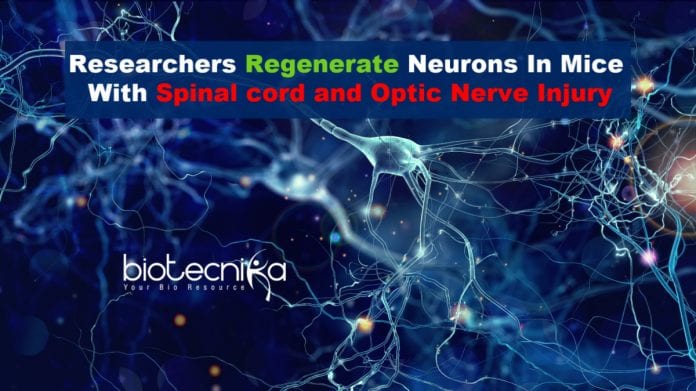Researchers regenerate neurons in mice with spinal cord and optic nerve injury
Like power lines in an electrical grid, lengthy wiry projections that grow outward from nerve cells, called axons form interconnected interaction networks that run to all parts of the body from the brain. However, a break in an axon is permanent, unlike an interruption in a power line, which can be dealt with. Annually thousands of people face this truth, encountering life-long losses in sensation as well as motor function from spine injury and associated conditions in which axons are badly severed or damaged.
Researchers from the Lewis Katz School of Medicine, Temple University reveal in their new research that, functional healing from these injuries might be possible, thanks to a molecule that controls cell development called Lin28. This research is published in the journal of Molecular Therapy. When the molecule expressed above its usual levels, the Temple researchers describe the ability of Lin28 to fuel axon (neuron) regenerate in mice with spinal cord injury or optic nerve injury, making it possible for the repair of the body’s interaction grid.
Shuxin Li, MD, Ph.D., senior investigator on the study, Professor of Anatomy and Cell Biology and in the
Shriners Hospitals Pediatric Research Center, the Lewis Katz School of Medicine, Temple University said, “Our findings show that Lin28 is a major regulator of axon regrowth and a promising therapeutic target for central nervous system injuries”. The regenerative ability of Lin28 upregulation in the injured spinal cord of animals was demonstrated in this study for the first time.Dr. Li said, “Due to the fact that it functions as a gatekeeper of stem cell activity – the researches got interested in Lin28 as a target for neuron regeneration in mice”. “It manages the switch that maintains stem cells or allows them to distinguish as well as potentially contribute to activities including axon regeneration”.
Dr. Li and coworkers established a mouse model to explore the impacts of Lin28 on axon regrowth in which some of the animal tissues expressed extra Lin28. The animals were divided into groups when fully matured, that sustained spinal cord or optic nerve tract injury that attaches to the eye’s retina.
Shots of a viral vector (a type of carrier) were given to another set of adult mice, with normal Lin28 expression and comparable injuries, for Lin28 to check out the molecule’s direct impacts on tissue repair.
The most remarkable effects were observed adhering to a post-injury shot of Lin28 though extra Lin28 stimulated long-distance axon regrowth in all instances. Lin28 injection led to the development of axons to more than 3mm past the area of axon damage, in mice with spinal cord injury, and axons regrew the whole size of the optic nerve tract in animals with optic nerve tract injury. Assessment of strolling as well as sensory capabilities after Lin28 treatment disclosed considerable improvements in sensation and coordination.
Dr. Li explained, “A lot of axon regrowth was observed since there are no regenerative treatments presently available for spinal cord injury or optic nerve injury, this could be extremely substantial medically”.
To identify a safe as well as effective ways of getting Lin28 to damaged tissues in human patients is one of his goals in the near-term. For this, his group of scientists will need to establish a vector or carrier system for Lin28, that can be injected systemically and after that hone in on damaged axons to provide the therapy straight to multiple populaces of nerve cells’ population.
He added, that he wants to figure out the molecular information of the signaling pathway of Lin28. “Other growth signaling molecules are very closely associated with Lin28, and we suspect to regulate cell development it uses multiple pathways”. These various other molecules can possibly be packaged in addition to Lin28 to help repair nerve cells.
Other researchers contributed to the work includes Fatima M. Nathan, Shuo Wang, Hua Guo, Xinpei Jiang, Armin Sami, and Yosuke Ohtake, Shriners Hospitals Research Center and the Department of Anatomy and Cell Biology, the Lewis Katz School of Medicine, and Solomon H Snyder, Department of Neuroscience, and Feng-Quan Zhou, Department of Orthopaedic Surgery, Johns Hopkins University School of Medicine.
The research was funded by the Shriners Research study Foundation and partially by the National Institute of Health grants R01NS105961, 1R01NS079432, and 1R01EY024575.
Author: Sruthi S





























